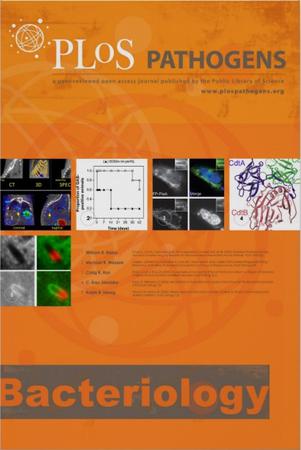Elasticity of the HIV-1 core facilitates nuclear entry and infection
IF 4.9
1区 医学
Q1 Immunology and Microbiology
引用次数: 0
Abstract
HIV-1 infection requires passage of the viral core through the nuclear pore of the cell, a process that depends on functions of the viral capsid. Recent studies have shown that HIV-1 cores enter the nucleus prior to capsid disassembly. Interactions of the viral capsid with the nuclear pore complex are necessary but not sufficient for nuclear entry, and the mechanism by which the viral core traverses the comparably sized nuclear pore is unknown. Here we show that the HIV-1 core is highly elastic and that this property is linked to nuclear entry and infectivity. Using atomic force microscopy-based approaches, we found that purified wild type cores rapidly returned to their normal conical morphology following a severe compression. Results from independently performed molecular dynamic simulations of the mature HIV-1 capsid also revealed its elastic property. Analysis of four HIV-1 capsid mutants that exhibit impaired nuclear entry revealed that the mutant viral cores are brittle. Adaptation of two of the mutant viruses in cell culture resulted in additional substitutions that restored elasticity and rescued infectivity and nuclear entry. We also show that capsid-targeting compound PF74 and the antiviral drug Lenacepavir reduce core elasticity and block HIV-1 nuclear entry at concentrations that preserve interactions between the viral core and the nuclear envelope. Our results indicate that elasticity is a fundamental property of the HIV-1 core that enables nuclear entry, thereby facilitating infection. These results provide new insights into the role of the capsid in HIV-1 nuclear entry and the antiviral mechanisms of HIV-1 capsid inhibitors.HIV-1 核心的弹性有助于核进入和感染
HIV-1 病毒感染需要病毒核心通过细胞核孔,这一过程取决于病毒外壳的功能。最近的研究表明,HIV-1 病毒核心在病毒帽分解之前就已进入细胞核。病毒衣壳与核孔复合体的相互作用是核进入的必要条件,但还不够充分,病毒核心穿过大小相当的核孔的机制尚不清楚。在这里,我们证明了 HIV-1 核心具有高弹性,而且这种特性与核进入和感染性有关。通过使用基于原子力显微镜的方法,我们发现纯化的野生型病毒核心在受到严重压缩后会迅速恢复正常的圆锥形形态。独立进行的成熟 HIV-1 胶囊的分子动力学模拟结果也揭示了它的弹性特性。对四种表现出核进入能力受损的 HIV-1 胶囊突变体的分析表明,突变病毒核心很脆。在细胞培养中对其中两种突变病毒进行适应性改造后,又进行了一些替换,从而恢复了弹性,并挽救了病毒的感染性和核进入能力。我们还发现,囊膜靶向化合物 PF74 和抗病毒药物 Lenacepavir 能降低病毒核心的弹性,并在保持病毒核心与核包膜相互作用的浓度下阻止 HIV-1 核进入。我们的研究结果表明,弹性是 HIV-1 核心的一个基本特性,它使核进入成为可能,从而促进感染。这些结果为我们深入了解囊膜在 HIV-1 核进入中的作用以及 HIV-1 囊膜抑制剂的抗病毒机制提供了新的视角。
本文章由计算机程序翻译,如有差异,请以英文原文为准。
求助全文
约1分钟内获得全文
求助全文
来源期刊

PLoS Pathogens
生物-病毒学
CiteScore
11.40
自引率
3.00%
发文量
598
审稿时长
2 months
期刊介绍:
Bacteria, fungi, parasites, prions and viruses cause a plethora of diseases that have important medical, agricultural, and economic consequences. Moreover, the study of microbes continues to provide novel insights into such fundamental processes as the molecular basis of cellular and organismal function.
 求助内容:
求助内容: 应助结果提醒方式:
应助结果提醒方式:


